
Even if the shaping is not perfect, this is the best baguette I have ever tasted!
I was very intrigued when I saw the baguette recipe that Akiko posted on the Fresh Loaf, both by her pictures of the baguettes and by the mentioning of the 80% hydration (Thank you Akiko, you are truly inventive and inspiring!). I liked it immediately and could not wait to try it. Several tries and tweakings further, with lots of sharing and baguette debating with Akiko, I can say from the heart that this recipe lives up to it’s expectations.
So give this recipe a try too and let me know what you think!
Do not forget to watch me take on the 80% baguette dough and see me stretch and fold on my video; Watch it here…
Take a look at our baguette log and follow our baguette baking progress and learn from our experiences and mistakes!
If you consider yourself a novice baguette baker our ‘easy’ baguette recipe might be a great place to start for you!
Before you start, you might also want to check our tips for bread scoring with confidence and handling wet dough.
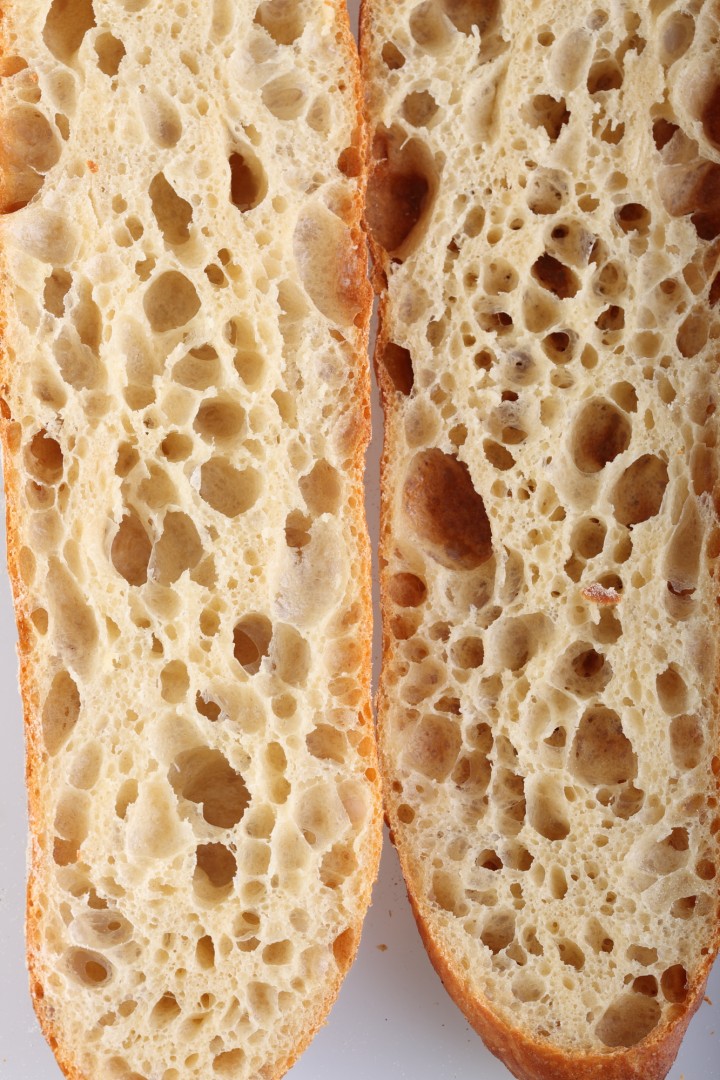
Making the ‘Poolish’
Normally a poolish has equal parts of water and flour, however this time we make a poolish of 80% water which will give you a preferment resembling something between a biga and a poolish. So it is less wet and much less slurry than an actual poolish. In a bowl stir together 380 grams of bread flour with 304 grams of cold water and 3 grams of instant dry yeast. Mix it until you have a consistency that looks like very thick dough-like batter. Cover the bowl and leave for one hour at room temperature. After this hour at room temperature you put the poolish in the fridge for 10 to 17 hours. So if you want to begin your bread making in the morning, you can make your poolish the evening before.
| Ingredients for the Poolish | ||||
|---|---|---|---|---|
| 380 | g | wheat (bread) flour | ||
| 304 | g | water (room temperature) | ||
| 3 | g | instant yeast | ||
| Ingredients for the Baguettes | ||||
|---|---|---|---|---|
| 1 batch makes 4 baguettes (346 g each) | ||||
| the poolish from step 1 | ||||
| 380 | g | wheat (bread) flour | ||
| 304 | g | water | ||
| 12 | g | (sea) salt | ||
| 1.5 | g | instant yeast | ||
Making the Baguettes
The times given in this recipe work best if your room temperature is between 19ºC / 66ºF and 23ºC / 73ºF. If your room is colder, use room temperature water instead of cold water (straight from tap) in the final dough.
Please note: There is no real mixing or kneading in this recipe. It’s all stretch and fold!
Now on with the final baguette dough making: Take the poolish directly from the fridge and first add the 304 g of water to dilute it. Then add the other ingredients (flour, salt and yeast) and combine until you have a shaggy mass. Cover and leave to rest for 10 minutes. Now turn out the mass onto your working surface and stretch and fold for 2 minutes. Keep on at it because it doesn’t look like it’s going anywhere but it will be OK. Put the dough in a greased bowl, cover and leave to rest for 45 minutes.
Stretch and fold a second time, doing two sets ( letter fold: right over left, left over right, bottom over top, top over bottom, repeat)
But back in your bowl, cover and again leave for 45 minutes.
Repeat the above stage another 3 times, but now each time doing only one set of stretch and fold.
Every stretch and fold is followed by a 45 minutes rest in a covered bowl except for the last one. After the last stretch and fold you leave the dough covered with some clingfilm (now looking nice and plump) on your bench for only a 10 minute rest (bench rest).
Preheat your oven to 240ºC / 465ºF (at what stage you preheat your oven depends on how long it takes for your oven to heat through, some take 30 minutes, some, like ours, with stone floors take a lot longer, up to two hours.)
Now divide the dough into 4 equal parts. You are going to pre-shape the dough parts one by one by carefully stretching the corners making a rectangle of each of the 4 pieces and rolling them up. Try to make your rectangle and roll as even as possible without fussing too much with the dough. Use enough flour to handle the dough, but try to keep it to a minimum because you don’t want too much extra flour in the carefully build up 80% hydration dough. Cover and leave to rest for 15 minutes.
Take a roll of dough (which has flattened a little bit during the bench rest) and gently shape it into a baguette shape. My way of shaping this high hydration dough is to sprinkle it with a little flour and press it softly down into a rectangle with a short and a long side. The more even the rectangle the nicer the baguette will look in the end. With a plastic dough scraper you flip 1/3 of the long side onto itself and tuck it in to get some tension on the outside of the dough, now repeat it two more times until you have a roll shape. Make a rolling motion with your cupped hands from the center to the side with a soft touch to make the baguette a bit longer and to make nice pointy ends on both sides of the baguette. Practice makes perfect, do not be hard on yourself, it is not an easy job with a dough as sticky as this.
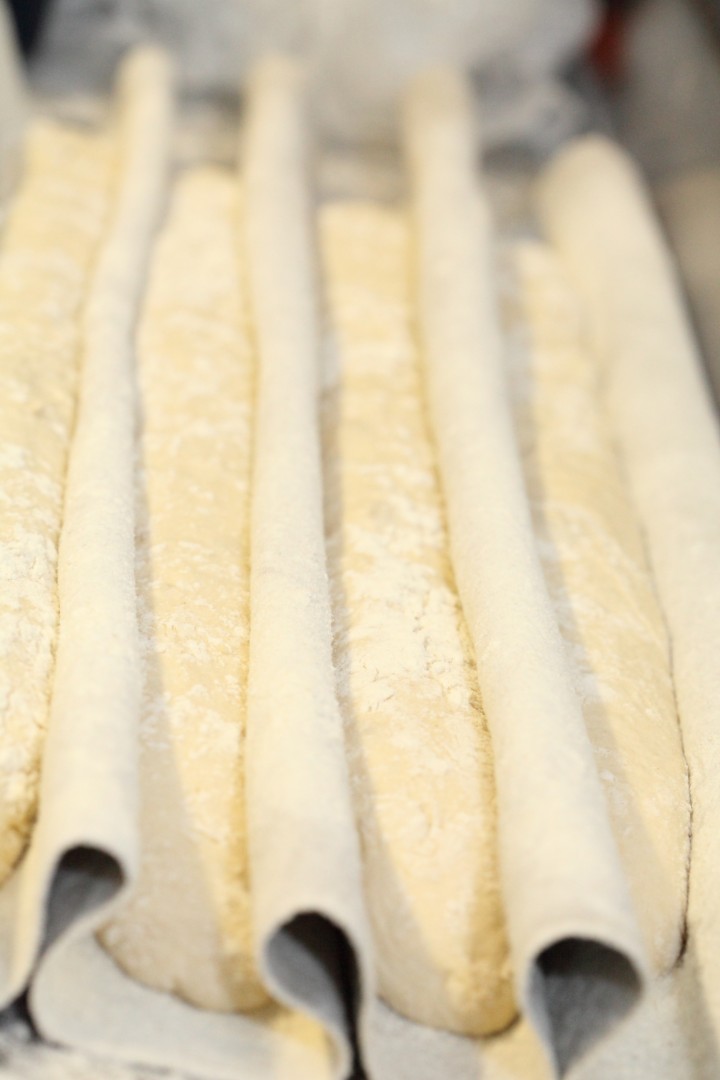 Place the baguettes in a couche made of proofing linen or in a baguette pan, or something of your own invention, but make sure the baguettes have enough side support to hold their shape. Cover them and leave to proof for 25 minutes.
Place the baguettes in a couche made of proofing linen or in a baguette pan, or something of your own invention, but make sure the baguettes have enough side support to hold their shape. Cover them and leave to proof for 25 minutes.
To check if the baguettes are ready, dip your finger in some flour and gently poke in your dough.
If the hole disappears completely: under-proofed
If the hole dent pops half way back out: proofing is just right
If the hole stays entirely dented in: over-proofed
Score the top of the baguettes with a lame/bread scoring tool. Cut as straight along the long axis of the loaf as possible. Mentally divide the baguette into lengthwise thirds, and keep the cuts within the middle third. You can practice the scoring on a piece of paper or a kitchen paper roll first. Overlap the cuts by about one third of their length,while holding the knife at a 30 degree angle. Also check out this very useful video on proper baguette scoring.
Bake in the preheated oven for 25 minutes. Leave to cool on a wire rack.
To get a nice crust, try to create some steam in your oven by putting a small metal baking tray on your oven floor when you preheat the oven and pouring a half cup of hot water immediately after putting the bread in the oven. Release some steam by setting your oven door ajar (perhaps with the help of a wooden spoon or oven mitt) 5 minutes before the bread is ready. If you are going to create steam with a baking tray, you maybe also want to turn your oven temperature a bit higher, because you are going to lose some heat in the process.
Baguette Time Table
Day 1
Make ‘poolish’
Day 2
Mix ingredients until shaggy mass
00:00- 10 minutes rest
00:10 – 2 minutes stretch and fold
45 minute rest
00:57 – 2 letter folds
45 minute rest
01:42 – 1 letter fold
45 minute rest
02:27 – 1 letter fold
45 minute rest
03:12 – 1 letter fold + bench rest
03:22 – divide + pre-shape
03:37 – shape + proof
04:02 – into the oven
04:27 – take out and leave to cool
PS: If you are interested in linen couches / proofing cloths like we use ourselves, you can find them in our WKB webshop.








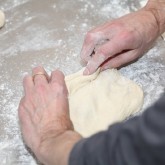

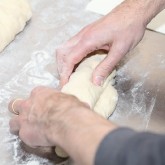






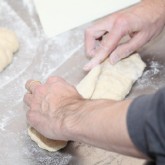
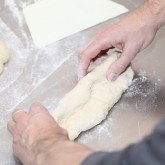
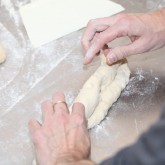


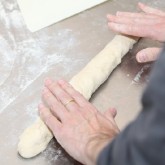
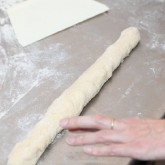








Avi Israel says
Thanks for the receipt and all the details, it’s very appreciable. I’ve just made 4 loaves and very satisfied. Scoring went well but since the dough was wet inside, the edges of the cut got stick to each other (both sides) at the beginning of the baking, and eventually there was no score anymore. The inside was nice and tasty. I will be glad in case you have any tip for me with regard to scoring a high hydration dough. Thanks a lot! Avi.
Weekend Bakers says
Hello Avi,
Thank you for letting us know. It sounds like you need to cut deeper and at the right angle. Check out our tips for scoring with confidence: www.weekendbakery.com/posts…onfidence/
Hope this helps you and happy scoring and baking!
Marieke & Ed
Ian C. says
We spend a lot of time in France and love the slightly chewy texture of the bread and the wonderful crust. I’ve tried a lot of recipes and this is the closest yet. A fabulous recipe, a bit of work, but excellent instructions and very well worth the effort. The steam really makes a difference. Thank you.
Weekend Bakers says
Hello Ian,
Thanks for the excellent feedback. Very happy the recipe works for you too!
Ed & Marieke
H. Johansson says
Hello,
I tried your easy baguette recipe and it was ok, so I decided to challenge myself with 80% hydration recipe. I did everything according to the recipe but the dough never became plump even after the 4th stretch-and-fold. It was beyond sticky…it was blotchy and almost liquidy. There was no way I could shape it so I put it in a ceramic casserole and bake it. It came out a bread alright but the crust was grayish white (maybe because too much water or I fussed with it too much?) and the interior was too dense than I wanted it to be.
Do you have any idea why my dough became too wet? I know this is very difficult thing to answer without actually seeing how I did it, but is there a common mistake that one can make in this recipe? It tasted better than the “easy baguette recipe” so I would like to do it again…
Sincerely,
H. Johansson
Weekend Bakers says
You are right, it is hard to judge for us. Keep in mind that all flour is different and has a different absorption level. Most of the time you just need a few runs to get it right. Our suggestion in your case would be to make the 80% recipe again but with around 75% hydration. This way you probably will be closer to the mark and the shaping will be easier too. From this point you can maybe work a little closer to the 80% again or keep it closer to 75 if you like the result.
Happy baking!
H. Johansson says
I tried as you suggested. Success! The interior is still uniform and lacks big airholes, but it is the best result I got so far. It tastes great! I will continue and move up to 80%. Thank you for your advice, Weekend bakers!
/H
julie says
Made this to the recipe except I forgot to put poolish in refrigerator. However the room the temperature was cool. My shaping technique needs a lot of work, but wow the taste. Perfect! Everyone loved them. Real baguettes. Crunchy, chewy and full of flavour. Was a bit of work for me since I’ve not done a lot of bread baking but was fun and a lot quicker than a trip Paris. Your meticulous lessons got me through. Many thanks.
Weekend Bakers says
Hi Julie,
Thank you so much for the excellent feedback. It’s a bit of work, but so worth it every time.
Happy baking!
Ed & Marieke
Daniel says
What about the room temperature..??? I live in indonesia that is about 28-31 celcius.
This is so difficult for the resting method.
And what about using instant yeast, n how.
Thank you Gbu
Weekend Bakers says
Hello Daniel,
Try to use a fridge to aid you. And you can use less instant yeast and adjust the recipe a little bit.
Martin Lax says
Just wanted to say thank you for such a fantastic recipe. Just tried it yesterday and got the best baguettes I’ve ever made, both crust and crumb exactly as I’ve been trying for. It has definitely made me a stretch and fold fan. I’m thinking there is probably no reason the recipe wouldn’t work for a batard as well, what do you think?
Regards,
Martin
Weekend Bakers says
No problem, we also use this recipe (with less water) to make boules shape breads. Happy baking!
margie laughlin says
Can you make the poolish with sourdough instead of yeast?
Weekend Bakers says
Yes, this is possible, however we like the taste of the baguette better with yeast and without sourdough. Happy baking!
luiz domaszak says
Congratulation for so nice recipes
Rachel Page says
Wow, this french bread is very well made! Looks so good.
Francisco Gutierrez says
thanks for the baking class! this is great stuff! I wonder if there is a way to shorten the time of making the poolish bread recipe? maybe by cutting the time of folding and resting? I will make this recipe by tomorrow! I already have the starter. Thanks!
Pancho.
Lynn Macdonald says
Hi there!
I am from Durban, South Africa and a few months ago discovered your website. Its wonderful, so thank you so much for the lovely videos that make it all so much easier. I have made a few of your recipes but absolutely just love your 80% baguette! In SA we have cake flour and bread flour, but the cake flour is the strongest and more suitable for bread baking. Over the past 2 years I have discovered the joy of bread baking and I must admit, its like an addiction…but a very good one 😀
Once again – Many thanks!!
Blue Skies 😀
Weekend Bakers says
Hi Lynn, we process of making baguettes is very rewarding, and we love the sweet soft crumb with the crusty crust. Just had a look at your website and we love the ‘braided cinnamon bread’ recipe when you slice and braid the roll of dough. Very nice!
chad says
Is a large crumb only possible with the stretch and fold method?
Weekend Bakers says
Hello Chad, it is hard to get this kind of crumb while using a mixer. We have ‘another’ baguette recipe, see our ‘easy baguette recipe’ which uses a mixer. However the crumb does suffer a little bit. Happy baking!
Ruther Budhi says
1) Can the mixing and folding be done using a mixer? If so, will the results be the same?
2) Does the type or brand of flour matter? If so, please specify.
3) Does the type or brand of yeast matter? If so, please specify
.
Thanks.
Weekend Bakers says
Hello Ruther, you sound a bit like my old schoolteacher 😉 Every type/brand of flour will produce a different loaf of bread. So try a few brands / types in your country with the same recipe and choose the one you like. The difference in yeast is less apparent / big, we just take the one we can get best in our region. Happy baking!
Cornelia says
Living in the US is great but most of the bread that you buy over here isn’t or it is massively expensive. For the first time we succeeded making a real artisanal bread. It really tasted like a French baguette. Our bread maker will be sold in the next garage sale…. Thank you for the recipe
Weekend Bakers says
Thanks, baking bread is indeed very rewarding!
Hai C says
Hello, I just made this bread over the weekend, it was outstanding and quite easy without the kneading! I did have to add about 10-12 g more water than the recipe called for poolish/dough, as the poolish and the dough mixture didn’t look to match yours in the videos. I was happy that it turned out, guessing the reason that I had to add water is due to inaccuracy of my scale, my scale goes out to 11 lbs and i couldn’t even weigh out 3g of yeast, had to guesstimate from a small packet, hehe.
In any case, I have a party coming up and am wondering about the final 25 minute proof (after the dough is fully formed). I’m wondering if it’s possible to form the dough, leave in the fridge overnight and proof/bake the next day.
Many thanks for sharing this recipe and your help.
Hai
Willem SPIJKER says
HALLO ,
HEBBEN JULLIE HET RECEPT VAN STOBROOD /BAQUETTES OOK IN HET NEDERLANDS EN ZOUDE JULLIE MIJ DAT KUNNEN / WILLEN MAILEN . (IK BEN ZO SLECHT IN HET ENGELS )
BIJ VOORBAAT DANK EN VRIENDELIJKE GROETEN
WILLEM SPIJKER
Weekend Bakers says
Hallo Willem, op dit moment is het baguette recept nog niet beschikbaar in het Nederlands, misschien in de toekomst. Al onze Nederlandse recepten kun je hier vinden;
www.weekendbakery.com/posts…tegory/nl/
Monique says
My website just got put up by my son, and there is really nothing on it at this time. I am starting a business baking baguettes and making candles. I am also baking Linzer Tortes for the holidays.
I baked baguettes way back in the 70’s to make a living as a starving student. I am now starting up again to make a living as a starving retiree – well, not starving, but extra money doing what I love is always nice. I really didn’t know much about how to make baguettes, and back then people weren’t as food savvy as they are now, and they thought that my baguettes were the best.
Your recipe is superb! I just baked my first baguettes using your instructions, and they came out perfect. It takes a long time, but what an amazing result! Especially doing it at home with a built-in oven. The oven is electric and there is no bottom to place a water pan, so I just quickly sprayed water from a spray bottle. Since I didn’t have the proofing linens, I made shapes out of heavy duty foil, and it worked great.
Thank you so much for posting all the information!
Weekend Bakers says
Thanks for your kind words. We wish you all the luck on your baguette adventure!
Sandra Lai says
Hi,
I adore your recipes, very detailed instructions with pictures and videos! Tho I didn’t have much luck with this 80% hydration baguette recipe….the texture turned out to be chewy which is what I like, but the holes were as big as the ones in the pictures. I used French bread flour, could it be why? And the dough was really wet…and i couldn’t pre-shape and shape it properly…could it affect the crumb as well? Thanks so much!!
Weekend Bakers says
Sorry to hear. All flour is different. We have baked the 80% baguette with different types of flour and they all looked and tasted differently. So our advice it to a) lower the amount of water until you are comfortable with the stickiness or b) try some different flours. Yes, it is sticky and it is soft but it should still hold shape, give either a) or b) a try. Happy baking!
Carlos says
Hi my name is Carlos I live in Manila here is always very hot and very humid and work,in the restaurant so temp is like 47 degrades always .Tiipes of flower here 1 white bread flower or cake flower . Is that ok? And as iWork in the kichen I have 2 hour to get bread done so what can I do ? You recepie take way to long go be ready for lunch
And dinner same 2 hours mice &’place But I really love your bread I finally after looking for years it look amazing finally some give real recipe that they work . I try many on the web I buy lost of books but they never work . Chefs ALWAYS keep their secrets and bakers too.
So what can i do for a restaurant ? baguette or sour … Time temperature
If you help me I promise to cook for you a dinner here .
Thanks you
Weekend Bakers says
Hello Carlos,
Wow you have quite a few challenges to deal with. First of all always use the right flour for the bread you want to make. If you can only choose between cake and bread flour, of course you should use the bread flour.
Can we conclude that you do not have much experience with bread baking? Because if this is so, making these very wet dough baguettes, with limited time, would not be the best place to start. May we suggest making something like our crusty white loaf first: www.weekendbakery.com/posts…hite-loaf/
You could make this loaf on ‘day1’ and then keep it in the fridge (covered of course) and bake it the next day or your next shift. You have to get some experience under your belt and experiment with times, amounts of yeast used and the whole process to get it right. Another suggestion that would fit your schedule is this bread:
www.weekendbakery.com/posts…istachios/
You can very easily make your own version of it and vary the ingredients.
We do not have a ready made solution for you because making good bread is not that easy, you have to be exact and there are lots of factors to consider, next to that you have your extra challenges. So we would suggest you start simple, get the feel of the dough, use the fridge to retard the dough so you can break up the process to fit your time schedule too. We wish you lots of success with everything and hope you will have great results soon.
Happy baking!
Ed & Marieke
Margaret says
Hi Ed & Marieke,
I am new to bread baking and came across your website by chance while searching for baguette recipes. Thank you for your recipe and the step by step procedure with pictures and videos. I have tried a few recipes and found this to be the best, very close to the baguettes bought at artisan bakery stores. The crumb/texture is nice and bread smells good. But after cooling down about 3 hours later, the crust becomes soft. Could it be the humidity? I live in Singapore and it is humid here year round, about 95% humidity level. Is there any way to preserve the crispy crust?
Cheers,
Weekend Bakers says
Hello Margaret,
Yes, you are very right, the humidity does play a big role as moisture from the outside gets in the crust, making it soft. And also moisture that is still in the core of the bread travels to the surface, so it is important to bake the baguettes to perfection and eat them directly after they are cooled. Baguettes do get stale quick and that is the reason bakers in France bake them often many times a day. In your environment with the humidity it is an extra challenge, so waiting for three hours is already very long. At that point you could return it to the oven for 5 minutes to get it crusty again.
Happy baking and eating!
Marieke
Rose says
After doing the process , my dough is still wet, what do I do? Do I add more flour?
Weekend Bakers says
This dough is supposed to be very wet and sticky, that is also the big challenge of this recipe. Please read the notes and instructions carefully and also take a look at our baguette video to see what this dough is supposed to look like:
www.weekendbakery.com/posts…tte-movie/
If you are not used to these wet doughs, you can start by using 70 to 75% water instead of 80.
You can also check out our tips for working with wet dough: www.weekendbakery.com/posts…ion-dough/
Good luck with it!
Rose says
I need a measuring cups conversion for this recipe .
Weekend Bakers says
Hello Rose
Here are the quantities expressed in volume for you:
Poolish
Flour (100%): 380 g | 13.4 oz | 0.84 lbs
Water (80%): 304 g | 10.72 oz | 0.67 lbs
IDY (.79%): 3 g | 0.11 oz | 0.01 lbs | 1 tsp | 0.33 tbsp
Total (180.79%): 687 g | 24.23 oz | 1.51 lbs |
====
Dough
Flour (100%): 380 g | 13.4 oz | 0.84 lbs
Water (80%): 304 g | 10.72 oz | 0.67 lbs
IDY (0.394%): 1.5 g | 0.05 oz | 0 lbs | 0.5 tsp | 0.17 tbsp
Salt (3.157%): 12 g | 0.42 oz | 0.03 lbs | 2.15 tsp | 0.72 tbsp
Total (183.551%): 697.5 g | 24.6 oz | 1.54 lbs
Calculations graciously provided by a wonderful little tool located here:
www.pizzamaking.com/dough_tools.html
Troy Baucom says
AMAZING crumb structure!!! Even and porous all the way to the thin crust…
– Troy
Weekend Bakers says
Great to hear Troy,
Happy baking!
Petra Robinson says
What is the difference between Stretch & Fold and Letter Fold?
Weekend Bakers says
With letter folding you simply fold the dough like a letter, without stretching the dough, simply folding like paper. You use this to make the layers of croissant dough. With stretching and folding you stretch the dough like an elastic band before folding it over itself. This develops gluten! Happy Baking!
Fin says
Amazing recipe and procedure. I have never made these before (only my 5th time making bread) but the steps are so easy to follow and the resulting bread was really astounding – better than in the local French bakery. Well done on this post – bookmarked forever.
Weekend Bakers says
Thanks, practice makes perfect!
Laura Pedraza says
Hello, i am proofing my dought just now, but i wonder if i had a bakery, is it really necessary to fold the dough every 45 minutes?
what if i just knead the dough until its all nice and smooth, let it proof for 1 to 2 hours, then shape and proof again then ready to the oven? will i have the same texture, flavor and holes in the bread?
Weekend Bakers says
Hello Laura, mixing the dough fully until nice and smooth will give a very different crumb structure. The whole proces of making the poolish, chilling and all the stretch and folds will give the nice open structure and big wholes. We have another recipe which is ‘simpler’ but also does give a different structure. Happy baking!
Michael says
Hi can you use fresh yeast rather than instant and if so how much fresh yeast do you use. Usually where it gives a recipe for instant dried yeast I double it for fresh. Is this correct. Thanks Michael
Weekend Bakers says
Hi Michael,
Yes, you can very well do that. As a rule, converting from instant yeast to fresh yeast means you have to multiply by three. So 1 g instant means 3 g fresh yeast.
Happy baking!
Kristin says
Hi. I halved this recipe and used t55 flour. Gluten development I believe was inadequate as I could not achieve a plump loaf in pre-shape or shaping but I did get lovely oven spring which was never achieved in my 6 previous attempts at baguette making. I believe my failure lied in 1. Too low of hydration percentage and 2.over proofing. My loaves sagged which resulted in a very flatbottom but the volume was still lovely. I may try again at 80%, and perhaps drop the hydration to 75 or 70, which I think will still result in lovely baguettes but perhaps I will have more success in shaping with this lower hydration percentage. My dough stuck dreadfully to the counter, and I was worried that I was ruining much of the structure when moving them to the baking pan, but it was not the case.
I will be trying this again in America with typical all-purpose flour.thank you for the recipe and information, and for anyone who wants this in standard measure, it is extremely hard to achieve proper hydration by volume (volume is incredibly inaccurate). invest in a scale you can get them at around $20.
Stylushlife says
I’ve made this recipe twice already and it’s absolutely genius! It’s exactly what I was looking for in a french baguette recipe. The only thing I changed was I used unbleached flour. After doing some serious research and using google translate to understand some recipes I realized a lot of the traditional recipe’s used unbleached flour. I personally love the results, soft, chewy, with a hard crust! It’s heavenly! I figured out a few tips on the way that I will be adding to my blog. I will 100% reference back to your website as you obviously deserve the credit! It seems like you’ve really perfected this recipe. Thanks for sharing!
xo
Joanna C. Stylushlife.ca
Weekend Bakers says
Hi Joanna,
Thank you for your wonderful feedback. You cannot see it in our recipe but as a rule all the flour we use is organic, unbleached and stone ground in one of the lovely mills we have here in Holland. And you are very right about the result. It makes a big difference.
Many more lovely baguettes and loaves!
Happy baking,
Ed & Marieke
Gabe says
Is the oven in the video/recipe convection or not……..I am have having trouble figuring out which one is better for bread baking
Weekend Bakers says
Hi Gabe,
We use a Rofco stone bread oven, made in Belgium (Rofco.be). It has three layers of thick chamotte stone. The closest you will get to this is using a baking stone in your oven and using the conventional setting.
richard says
Hey, i tried a 75% hydration, but my baguettes crum was very elastic and a bit wettish. Did I overkneed? Or was my oven not hot enough..
Weekend Bakers says
Hi Richard,
We would first guess at your oven. As there is no kneading with this recipe, we cannot judge what you did exactly to ‘overknead’ the dough. To check your oven and improve on this point you can check these tips we have for you: www.weekendbakery.com/posts…your-oven/
Good luck with it and happy baking!
MCMARTZ says
Hi,
Great recipe.
I got a problem, my baguettes just made are great with nice crust and but after ten hours it gets uneatable, crust is like a stone and inside is like a gum, why could be that ?.
All best
Martz
Weekend Bakers says
Without any additives and added fat it is impossible to keep a baguette fresh for more than 2 hours. Baguettes are really mend to be eaten fresh. In France they throw them away after a few hours. We leave them to cool and eat them straight away too (or you can put them in the freezer and warm them in the oven, but they will not be as good as fresh of course. That is why, if we do freeze leftover baguette, we make baguette toasties with them, which works rather great).
Have a great (baking) weekend!
Ed & Marieke
SeaCottage says
Hi Marieke,
I am mighty grateful with your sharing of experiences and recipes in bread making. This is the 3rd recipe I am using and it has always been successful (of course need a lot of practice in shaping and scoring the dough). It is definitely a huge boast for a novice baker like me.
Thanks so much.
Weekend Bakers says
Thank you too for the lovely feedback!
Happy baking!
Marieke
Linda says
Hello Weekend Bakers!
I am awaiting the delivery of my Rofco B5 oven and wanted to gather some recipes to try out once I get it. On other websites I read that it is advised to preheat the Rofco oven on 210 or 230 degrees and then place the bread in the oven. After that, it is suggested to turn the oven temperature down as soon as the bread starts getting some color. Would that also be a good idea for the baguette or would you say it’s better to keep the oven temperature steady?
Thanks in advance for your answer!
Weekend Bakers says
Hi Linda,
Congratulations on getting the Rofco B5! We are sure you will like it. And for your question: in general you always use this turn down method when baking bread, so also for the baguettes. The heat of the stones remains but the glowing of the spirals is turned off when the right level of color is achieved. Usually this point lies somewhere between 10 and 12 minutes, but we do not have experience with the B5 so it might be a minute more or less and it also depends on the recipe, temperature and personal preference. But you will get the hang of it soon enough.
Happy baking with the Rofco!
Marieke & Ed
Linda says
Hi Marieke & Ed,
Thanks for the quick and informative reply! Also, I would like to take this opportunity to tell you that I ordered some items from your shop and I’m very pleased with the quick delivery. But not only that, I also happily noticed that there was a lot of thought put into the packaging of the items. It’s the little things that count! Great job.
Weekend Bakers says
Thank you so much Linda! It is wonderful and encouraging to hear these things.
And if you haven’t seen them yet, check out the tips we collected for Rofco oven users: www.weekendbakery.com/posts…ven-users/ There may be some handy suggestions for you too.
Have a great (baking) weekend!
Marieke